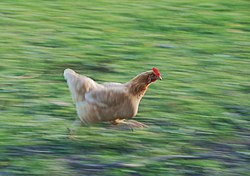Panning (camera)


In photography, panning refers to the rotation in a horizontal plane of a still or video camera. Panning a camera results in a motion similar to that of someone shaking their head "no" or of an aircraft performing a yaw rotation.
Film and professional video cameras pan by turning horizontally on a vertical axis, but the effect may be enhanced by adding other techniques, such as rails to move the whole camera platform. Slow panning is also combined with zooming in or out on a single subject, leaving the subject in the same portion of the frame, to emphasize or de-emphasize the subject respectively.
In still photography, the panning technique is used to suggest fast motion, and bring out the subject from other elements in the frame. In photographic pictures it is usually noted by a foreground subject in action appearing still (i.e. a runner frozen in mid-stride) while the background is streaked and/or skewed in the apparently opposite direction of the subject's travel.
In video display technology, panning refers to the horizontal scrolling of an image that is wider than the display.
The term panning is derived from panorama,[citation needed] a word originally coined in 1787 by Robert Barker for the 18th century version of these applications, a machine that unrolled or unfolded a long horizontal painting to give the impression the scene was passing by; Barker also invented the cyclorama in which a large painting encircles an audience.
Achieving a smooth pan in photography

When photographing a moving subject, the panning technique is achieved by keeping the subject in the same position of the frame for the duration of the exposure. The length of the exposure must be long enough to allow the background to blur due to the movement of the camera as the photographer follows the subject in the viewfinder.
The exact length of exposure required will depend on the speed at which the subject is moving, the focal length of the lens and the distance from the subject and background. An F1 car speeding along a straight might allow the photographer to achieve a blurred background at 1/250th of a second, while the photographer might need to go as slow as 1/40th to achieve the same amount of blur for a picture of a running man.[1]
The faster shutter speed allowed by fast moving subjects are easier to capture in a smoothly panned shot. With slower moving subjects, the risk is that the panning motion will be jerky, and it is also harder to keep the subject in the same position of the frame for the longer period of time.
To aid in capturing panned pictures, photographers use aids such as tripods and monopods, which make it easy to swing the camera along one plane, while keeping it steady in the others. A low budget option is to tie a piece of string around the lens, then to drop the other end to the floor and step on it to pull it taut. This will allow a little bit more stability and allow for smoother blur.[2]
References
See also
- Equatorial mount which allows astronomers to take pictures of stars and galaxies by compensating for Earth's movement
- Pan and scan
- Pan tilt zoom camera (PTZ)
- Tilt (camera)
- Tripod (photography)
- View camera
- Zoom lens
External links
![]() Media related to Panning at Wikimedia Commons
Media related to Panning at Wikimedia Commons
